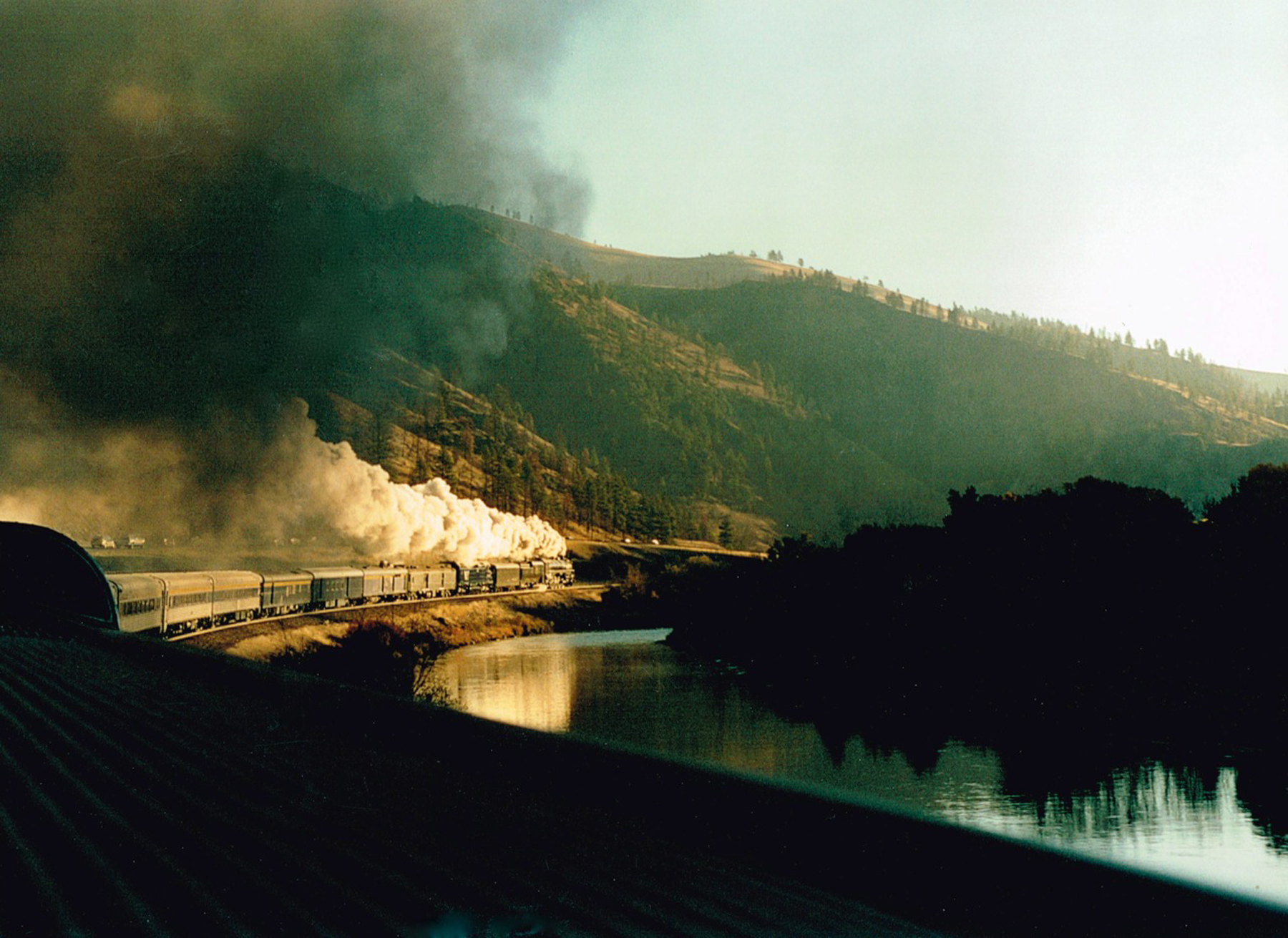Train Trips to Paradise: Montana in the Railroad, Homestead Eras (Part 2 of 2)
 Train west of Drummond: The fully restored Spokane, Portland and Seattle Ry #700 travels west of Drummond in October 2002. (Photo by Jack Dykstra)
Train west of Drummond: The fully restored Spokane, Portland and Seattle Ry #700 travels west of Drummond in October 2002. (Photo by Jack Dykstra)
After all these non-mechanized years, three railroads in the 1880's! Montanans were, literally, transported. The railroads mark a fundamental turning point, the greatest historical watershed in Montana history. All but ending the captivating river and wagon trades, they linked Montana to vital national markets. They opened the territory (and soon the state) to outside investment and exploitation. They goosed economic growth and development. W. G. Conrad said it all:
“The railroad … changed all the channels of business and many … were unable to adjust themselves to the new conditions it brought. The coming of the railroads annihilated time and distance … and annexed the country to the commercial territory of the great eastern merchant princes.”
By 1909, a third transcontinental, the Chicago, Milwaukee, St. Paul and Pacific (the “Milwaukee Road”) had cut through central Montana just in time to capitalize on the great homesteader boom. Railroads were absolutely essential to homesteading in central and eastern Montana – there’s almost a causal connection. Railroads brought farm families into the state with all their goods, livestock and equipment. They allowed grain growers and ranchers to ship their products to eastern markets. The Northern Pacific in 1900 was the largest landowner in Montana, and it had millions of acres to sell. The Great Northern and the Milwaukee Road depended for their very existence on filling up the plains – once home to widespread Indian nations and buffalo – with productive, Jeffersonian, agrarian yeomen. Their message to potential farmers all over America and Europe was simple: Come hither, and replenish the earth.
Factors other than railroad promotion and cheap transportation drew settlers to Montana after 1890. Land was free – 160 acres under the Homestead Act of 1862. The acreage doubled in 1909, and the proof period dropped from five to three years. Governments at all levels sought to attract citizens. Rainfall seemed ample, and if not, scientific agriculture – or dryland farming –promised good crops anyway. Commodity prices were high.
It all seemed so easy … free land, railroad competition, instant returns, endless markets, high profits. No wonder people poured into Montana – 103,000 in the 1890's, 133,000 in the 1990s, an incredible 173,000 in the 19-teens. From 1890 to 1920, Montana’s population exploded by nearly 300 percent. In 1910 on a single day in Havre, 250 homesteaders arrived. In 1913, each month, 700 people filed there. In March 1916, the number reached 1,200 a month. The plains areas alone accounted for more than 70 percent – 220,000 – of Montana’s population increase in the first two decades of the century.
Everything expanded – prosperity; population; land under cultivation; wheat production (both yield per acre and price per bushel); women, children, and families; the number of towns and counties; railroad trackage. The years 1900 to 1920 were years of frenzied railroad construction in Montana. The great transcontinentals sent feeder lines to the farthest hamlet, mine or forest. Steel rails crisscrossed the state. You could go anywhere, it seemed, on the iron horse.
Every boom, unfortunately, produces a bust. The homestead era began gradually and collapsed abruptly. When the Great War ended in Europe in 1918, the bottom dropped out of the market.
Commodity prices plummeted. A searing drought, for which even scientific agriculture had no remedy, scorched the plains. Crop yields imploded. Fire, wind, hail, plagues of locusts, a flu epidemic and dust storms of biblical proportions battered Montana’s grasslands. Paradise became hell overnight.
The same trains that had carried thousands of settlers into Montana for 30 years carried thousands away after 1918. Montana was the only state in the nation to record negative population growth in the 1920's. Though no one realized it yet, the railroad era in American history was over. Trains built the country and made Montana. But when Henry Ford rolled a cheap Model T off the Dearborn assembly lines in 1915, the world changed. Automobiles, trucks and highway construction constitute the next, enduring chapter in Montana’s transportation history.
It was a great ride for 15 or 20 years on either side of 1900. Railroads and homesteaders go together in Montana. Each had its glory days. We still have farmers in Montana, and trains, but the romantic connection is history.
Harry W. Fritz | University of Montana | Department of History
